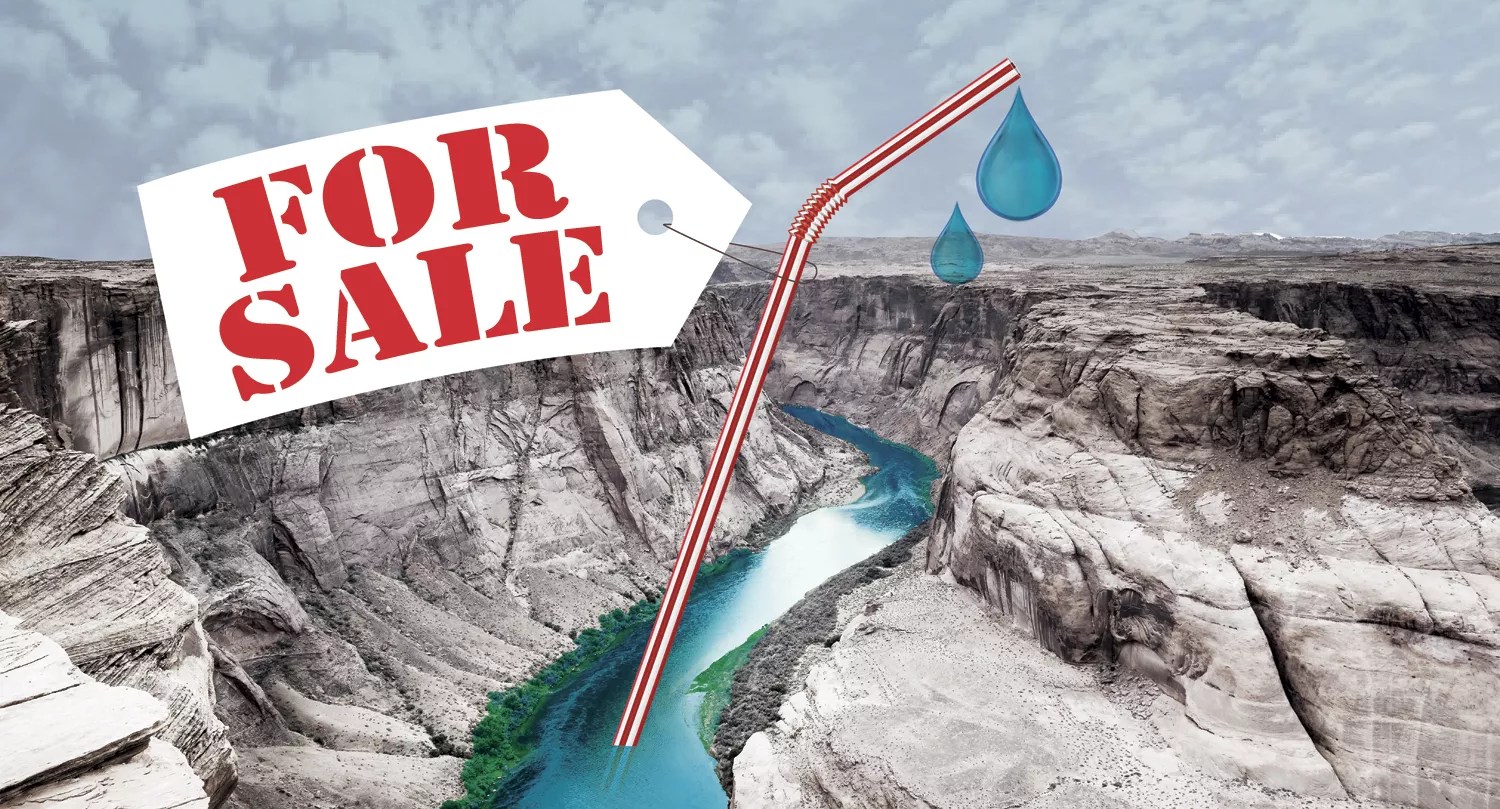
Lindsey Kelly/Phoenix New Times

Audio By Carbonatix
Last October, Dorothy Timian-Palmer was frustrated.
Over the course of two decades, Vidler Water Company, where she is CEO, had spent nearly $100 million in Arizona on water, land, permits, and construction. Now, the Southwest was in the throes of a 20-year drought, Arizona was bracing for epic losses to its supply of Colorado River water, and it was time for one of Vidler’s biggest investments to start paying off.
As Timian-Palmer had told investors, because Arizona would soon be forced to take less water from the Colorado River, “they’ll be out looking at additional water supplies.” During an earnings call in August, she said, “That means our credits” – water stored underground – “become even more attractive.”
Earlier in 2018, Timian-Palmer offered that water, of which it had more than 80 billion gallons (about 125,000 Olympic swimming pools’ worth), to one of the biggest water buyers, the Central Arizona Groundwater Replenishment District. The District was deeply affected by the impending Colorado River shortages, albeit indirectly, yet the people in charge of it didn’t seem particularly interested in her offer.
Phoenix, make your New Year’s Resolution Count!
We’re $11,000 away from reaching our $30,000 year-end fundraising goal. Your support could be what pushes us over the top. If our work has kept you informed, helped you understand a complex issue, or better connected you to your community, please consider making a contribution today.
The drought was supposed to be better than that for business. Vidler, a self-described water-resource company owned by NASDAQ-traded PICO Holdings, classifies shortages on the Colorado River as one of several “market catalysts.” From the beginning, it expected these shortages, coupled with rapid population growth, to fuel demand for its water.
Timian-Palmer tried again in September. Rather than negotiating a deal, she found herself lobbying against the water that the District’s managers wanted to buy instead from the Gila River Indian Community.
“I was trying to explain to them that I thought the project they were looking at was not going to go through, was going to be difficult, and cost a lot more than the credits we had,” she told Phoenix New Times. She shrugged it off as “just part of negotiations.”
On the afternoon of October 18, a few hours after the people who manage the District discussed that project, Timian-Palmer called Sharon Megdal. Megdal, an elected member of the board of the Central Arizona Project, chairs the committee overseeing the District.
“She thinks we’re quoting an artificially low price,” Megdal wrote in an email summarizing the conversation, referring to the cost of the deal with the Gila River Indian Community, which the District was comparing with other offers. Megdal sent the email to Ted Cooke, manager of the Central Arizona Project, and Laura Grignano, manager of the District. (New Times obtained this email, other emails, and proposals under public records law.) “She thinks that we’re not interested at all in Vidler’s credits. I think she may feel like she can’t make progress with Staff and said she may ‘go dark’ for a while,” Megdal added.
Timian-Palmer acknowledged her exasperation, explaining, “I thought at the time, we had a much better proposal.”
She wasn’t the only one who thought the District could do better.
Vince Vasquez, who worked for the hedge fund Water Asset Management, also disagreed with the district’s choice. He had called Megdal a week before Timian-Palmer did, leaving her a voice message, then sending an email asking to get coffee and chat about the District. Later, at Megdal’s suggestion, Vasquez contacted Grignano. He wrote that he had “some questions/issues” about the financial analysis of the Gila River Indian Community deal. “At a minimum the analysis provides a good reason to have a conversation with you about how these alternatives (and others) can be viewed,” Vasquez wrote.
One alternative, of course, was water from Water Asset Management.
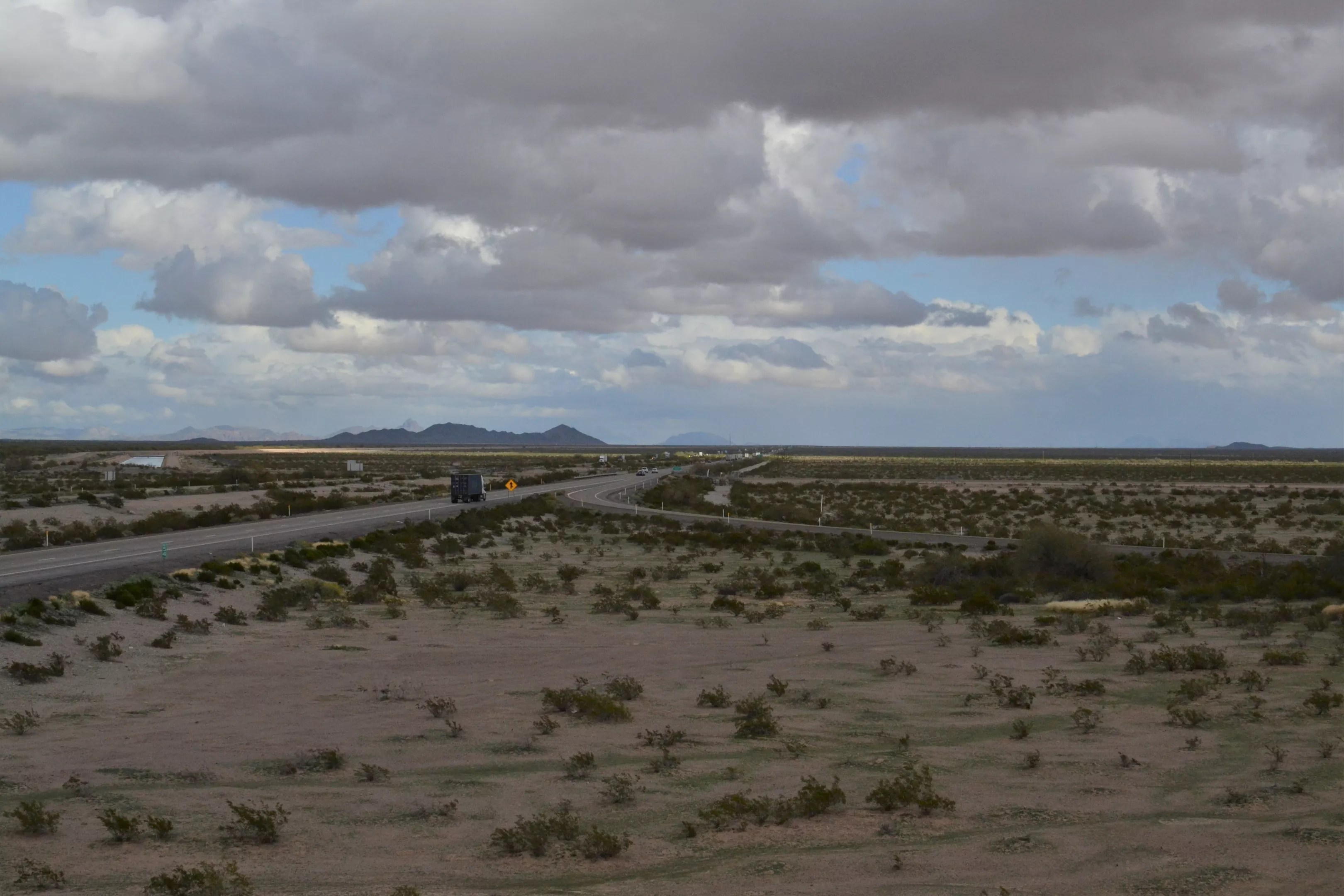
Beneath the dry surface of the Harquahala Valley lies a copious amount of groundwater.
Elizabeth Whitman/Phoenix New Times
Vidler and Water Asset Management are among a handful of companies vying to wring profits from the Southwest’s most critical, coveted, and contentious resource: water.
The water to which they own rights is less well-known than water controlled by tribes and farmers, but it is important enough that Timian-Palmer and Vasquez have the attention of staff at powerful institutions like the Central Arizona Project, and have a conduit to them via board members, especially Megdal.
The pioneer was Vidler, which got into the business in the mid-1990s, when supply was high and demand was low. The company could imagine the day when those circumstances flipped. Later, its co-founder left to start Water Asset Management; another employee split off and founded Greenstone, which, similarly, buys and sells water rights, stores water, and builds infrastructure. Vasquez declined to participate in this story; a spokesperson for Greenstone said Mike Schlehuber and Mike Malano, its CEO and vice president, respectively, could not be made available.
It’s easy to start speculating on water, experts say. Cashing out is not so simple.
Betting on water is a risky endeavor. Experts on water in Arizona say that while it’s easy to start speculating on water, cashing out is not. Would-be profiteers have to buy water or land with rights to it. They have to work within the thicket of laws and regulations governing water in Arizona and contend with the fraught politics of Western water. The ability to store water underground has also given rise to a market-like system in Arizona in which people talk about diverse portfolios and asset acquisitions. If speculators can navigate those mazes and hold out for demand to reach a tipping point, they could land deals worth tens of millions of dollars, maybe more.
Or could they? PICO Holdings, the public company that owns Vidler, and where Timian-Palmer is also CEO, has operated at a net loss five of the last six years, even as the company has landed a few multimillion-dollar deals. Last year, trying to reduce operating costs, Vidler went through a shakeup. Its chief financial officer stepped down and it closed its office in La Jolla, California, to concentrate operations at its headquarters in Carson City, Nevada. These latest struggles can’t be attributed to PICO’s other subsidiaries, because it doesn’t have any. And while Vidler also operates in Colorado, New Mexico, and Nevada, it considers its Arizona water one of two key assets (the other is in Nevada). Vidler declined to comment on the losses shown in SEC filings, but Timian-Palmer promised last year in a quarterly release to investors that the company’s water in Arizona “continue[s] to be highly strategic and valuable.”
With the Colorado River historically overdrawn and its water levels shrinking because of climate change, Arizona faces a reckoning. The environmental conditions causing shortages on the river are not an anomaly. Rather, they are evidence that, with climate change, dry is the new normal. Last year, the National Climate Assessment warned that because of climate change and a growing population, the Southwest needed to figure how to balance waning supplies of water with growing thirst for it.
Evolving regulations, meanwhile, promise greater flexibility for moving water around the state, and companies are still banking on the idea that one day, their patience will pay off.
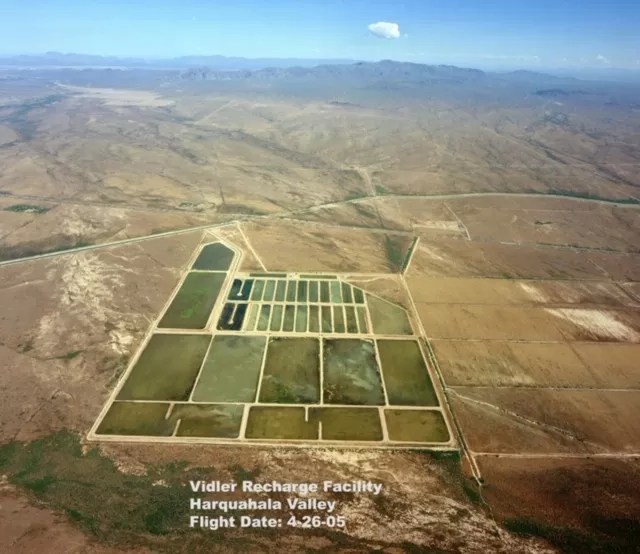
In 2005, Vidler was still storing excess Colorado River water underground.
Courtesy of Vidler Water Company
Drive west from Phoenix on Interstate 10 for an hour, and you’ll find yourself in a rocky plain, ringed by desert mountains, halfway between Phoenix and the California border. Other than the tractor trailers streaming east or west and the occasional maintenance truck, this scrubby land is deserted. Pull off the road, and you might spot a cow, hemmed in by cattle guards and barbed wire. Yellow signs warning of unmaintained roads are sprinkled with the telltale holes of target practice.
Using Google Earth, you can zoom out over the Harquahala Valley about two miles west of Centennial and detect the faded etchings of polygons in the tan ground – a 700-acre rectangle subdivided into a dozen or so smaller parcels. A dry ditch forges northwest from the divisions for several hundred feet toward a snaking blue-green line: the Central Arizona Project canal.
This parched spread of polygons, now defunct, remains one of the few visible clues to the modern-day prospecting that Vidler began in Arizona in the mid-1990s. Until about 10 years ago, these pools shimmered turquoise, filled with water from the Colorado River. Droplets seeped from the surface through layers of silt, sand, clay, and gravel until hitting the water table some 400 feet below. There they would remain, shielded from the evaporative forces of the Arizona sun, until someone decided to pump them up again.
The value of this remote land lies in its water. At least, people at companies like Vidler thought so when they started buying parcels of land there. Part of the appeal lay in the Harquahala Basin’s copious groundwater, but the greater allure was the location – its proximity to the Central Arizona Project canal, right where it crossed from La Paz County into Maricopa County. The Harquahala Valley was also one of only three rural areas that had water you could take and transport into an urban area, like Phoenix. In short, the area seemed tailor-made for selling water to cities, golf courses, developers, businesses, or others in central Arizona.
Vidler bought its first piece of Arizona land in this valley in 1997 from a group of business partners led by Eric Borowsky. They had bought the land from a cotton farmer who went bankrupt after he installed expensive drip irrigation.
“A broker friend of mine knew about the property and suggested we form a partnership to buy it for its water rights,” said Borowsky, who later became part-owner of Arizona Snowbowl. The idea was to sell it to a city – at the time, many contemplated buying property to augment their water supplies – but although they negotiated with several, a deal never went through.
Instead, Vidler found them. It purchased 760 acres from Borowsky and his partners, at a loss to them, Borowsky said. For three or four years after that, Borowsky served as one of Vidler’s real estate agents. The company bought land from farmers and leased it back, to keep it in cultivation and maintain its water rights until it could be sold.
“Their business plan was to make money on water,” Borowsky recalled.
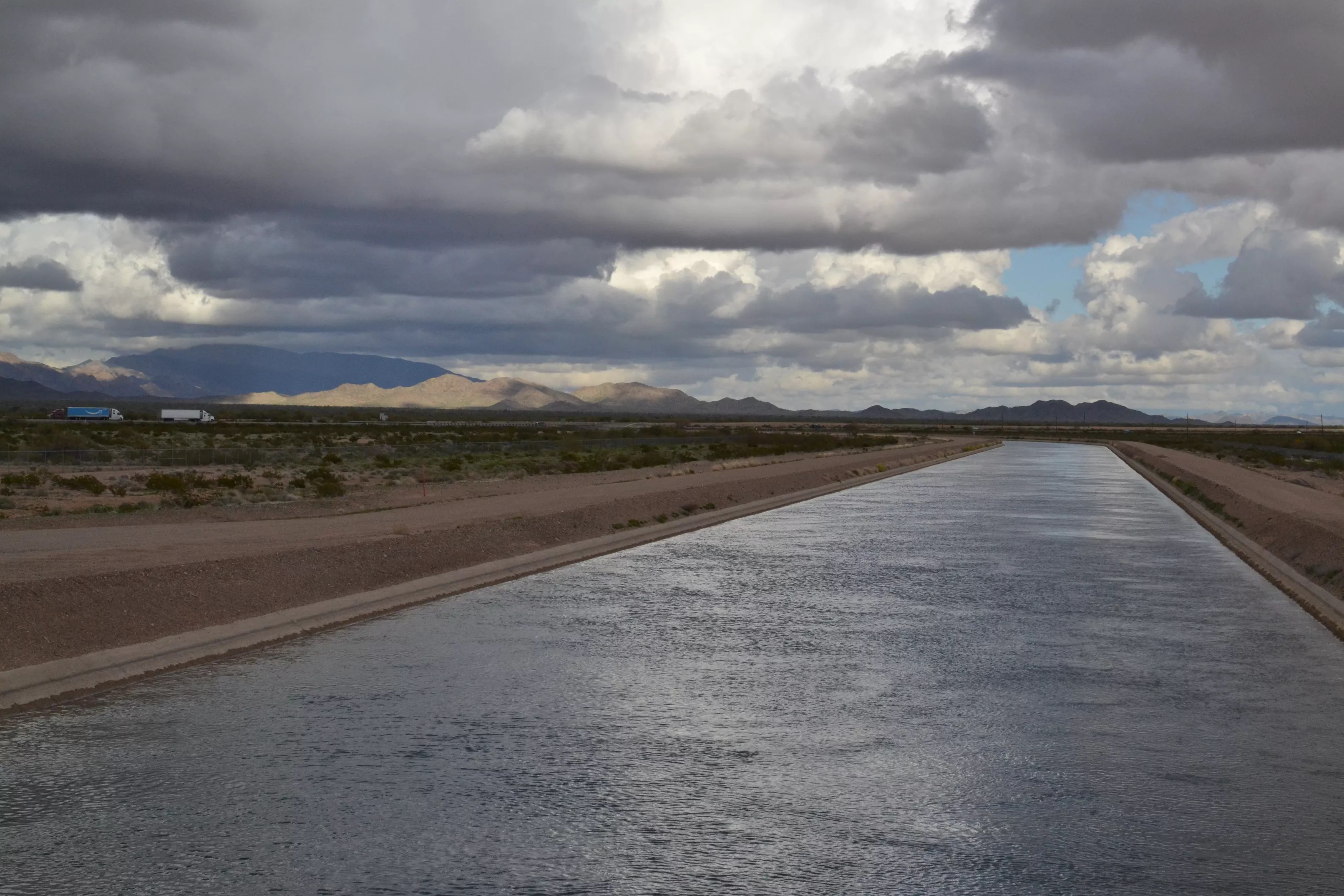
Location, location, location: The Central Arizona Project canal, which cuts through the Harquahala Valley, might seem like the perfect channel to transport water out of the Valley…
Elizabeth Whitman/Phoenix New Times
In Arizona, companies that speculate on water can try their hand in a few ways. They can buy land with rights to water, either ground or surface. Or they can purchase what’s called “paper water”- tradable credits for water artificially stored underground. They can also buy water, store it, and create those credits themselves. In Arizona, Vidler has done all three.
Timian-Palmer joined the company in December 1997, after it bought the land from Borowsky and his partners. A Tucson native, she graduated from the University of Arizona in 1984, then worked designing and installing drip irrigation in cotton fields. She then left for Nevada, working for the U.S. Department of Agriculture in Reno before heading to Carson City, where she eventually became the public works director.
Those who have worked with Timian-Palmer describe her as effective and efficient. “She’s very articulate,” said Megdal, the Central Arizona Project board member. Borowsky said she was “very qualified” – someone who knew a lot about water. Gary Small, a hydrologist once hired by Vidler, called her “the brains” behind the company.
In an interview in January, Timian-Palmer portrayed Vidler as a small but helpful player in the Arizona water scene. She met with New Times at the downtown Phoenix offices of Veridus, the lobbying firm that Vidler retains. Matt Benson, the lobbyist, sat in.
Timian-Palmer was reserved, firm, and direct. Vidler was not involved in Arizona’s drought plan, she said. Instead, the company’s water was for new growth and development, although she couldn’t predict who exactly would buy it.
“I mean, we sell to golf courses every quarter,” Timian-Palmer said. “Eventually, how I see it happening is, someone’s going to buy the credits.” (Vidler sells its Phoenix credits, not the water it has stored in the Harquahala Valley, to golf courses.)
From her perspective, after Vidler arrived in Arizona two decades ago, it built a project, employed people, spent money, and paid taxes, all to the advantage of the state – and Vidler’s shareholders.
“We are in the business of selling credits, and we don’t want to sell them at a loss,” Timian-Palmer said. “We think we’ve made a very sound business decision in the investments we’ve made in Arizona.”
“And Arizona’s benefited as well,” Benson chimed in. Timian-Palmer murmured her assent.
Benson continued, “I mean, this is a private company, that’s come in and it’s invested … and helped -“
“- keep water in the state,” Timian-Palmer finished.
Later, Benson added, “We don’t think it’d be fair to have Vidler get demonized as some kind of water profiteer.”
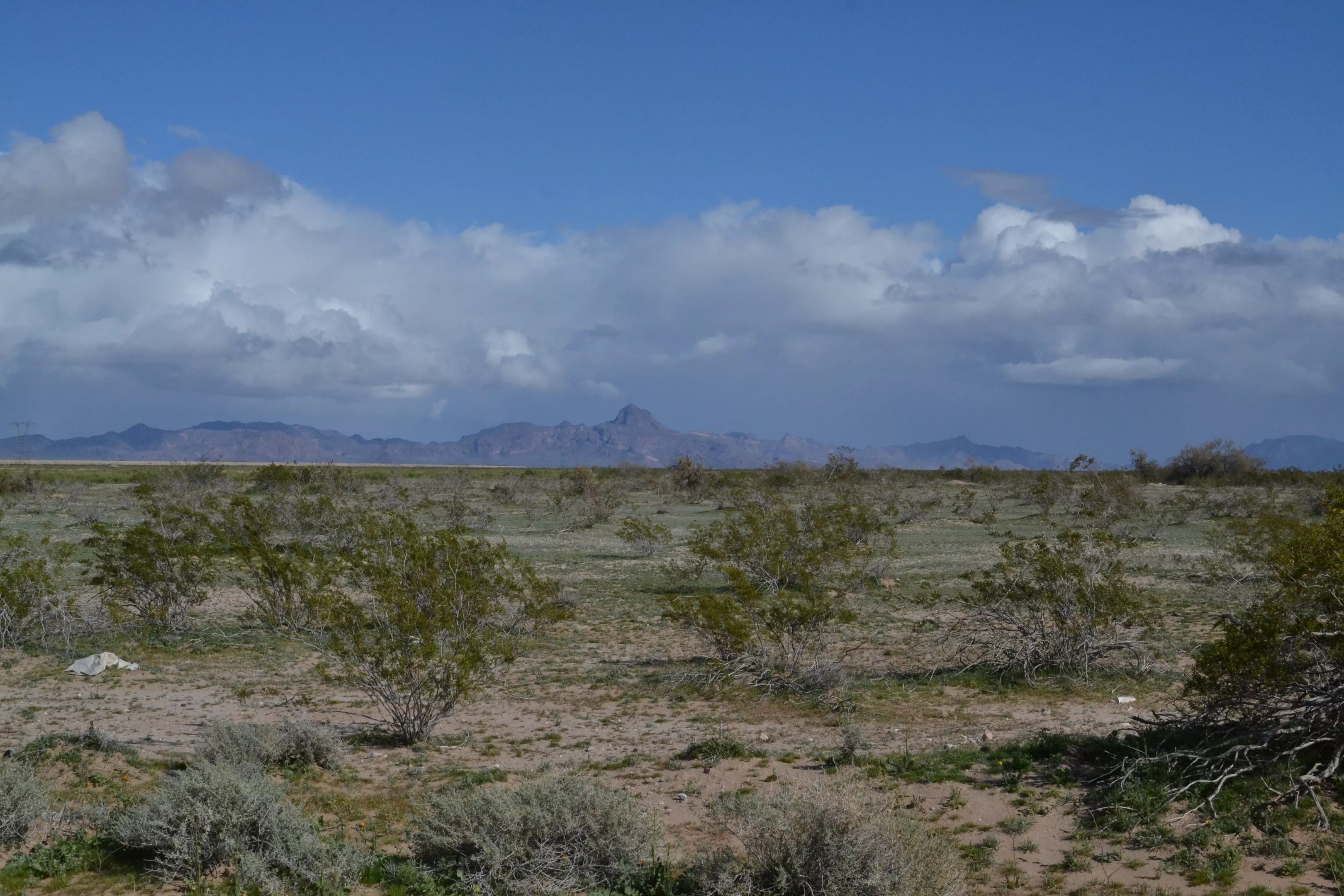
… but bringing water from the Harquahala Valley to counties in central Arizona comes with a host of technical and regulatory issues.
Elizabeth Whitman/Phoenix New Times
The 1990s were the heady days of water for Arizona. In 1985, the newly built Central Arizona Project began taking so much water from the Colorado River that the state did not know what to do with it. It couldn’t use its full allocation of 2.8 million acre-feet per year. (An acre-foot is just under 326,000 gallons of water, enough for a family of five for a year.) Any water left in Lake Mead, the reservoir on the Colorado River that Arizona draws from, would go to California, so in 1996, the state created the Arizona Water Banking Authority to take that water and store it underground. But even the water bank didn’t have the space or the money to store it all.
“The main issue became in the early years: Was there a place to put the water?” said Tim Henley, the bank’s first manager. Only after the Salt River Project, the Central Arizona Project, and cities built storage facilities could the bank partner with them and store the excess water underground. Any entity – a tribe, a city, a company – that stored water underground for a year accrued a credit that allowed them, someday, to pull the same volume back up again.
The new water bank highlighted Arizona’s need to prepare for long-term drought, said Maureen George, an attorney who represented the Mohave County Water Authority until she retired last year. Even in the mid-1990s, there were signs that someday, Arizona’s water supply would decrease.
“I honestly think the market, if that’s what we want to call it, was generated by the obvious overallocation of the [Colorado] river, as well as the drought projections,” George said.
In 1997, Vidler decided to build a storage facility on the land it purchased from Borowsky and his partners. The structure would transfer water to an aquifer, either by letting it sink through layers of silt, sand, clay, and gravel or by using a new technology, vadose zone wells, to inject it. Timian-Palmer estimated the company spent $15 million just to build the recharge project.
“It was, by far, the state of the art in those days,” said Small, the groundwater hydrologist who designed the pilot site.
Vidler’s parent company, PICO Holdings, Inc., calls drought on the Colorado River “a market catalyst.”
In those days, Vidler had a lofty vision for the Vidler Recharge Facility. By October 1998, the pilot project was up and running. It was likely “the first privately-owned water storage facility for the Colorado River system,” parent company PICO Holdings reported in its 10-K filing to the Securities and Exchange Commission in 2000. Once expanded to a full-scale facility, it would take in 100,000 acre-feet of water per year and could cumulatively store more than 1 million acre-feet, the company predicted.
“We anticipate that in the future, a significant amount of Vidler’s revenues and asset value may be derived from [this] single asset,” it said. “Potential users include local governments in Arizona, the Las Vegas metropolitan area, California, and the Bureau of Reclamation.” Vidler would charge users a fee depending on the amount of water stored, then more fees for recharging and recovering the water. It did not state how much those fees would be.
In those days, Arizona “pretty much encouraged people to come in and recharge water,” said Timian-Palmer. Excess Colorado River water was “competitively priced” if it went to underground storage, she added.
Patrick Dent, water control manager at the Central Arizona Project, confirmed that “special pricing programs were used” to encourage users to store water. For the 12 years Vidler bought and banked excess water, it benefited from those prices for 10 of them, enjoying discounts of up to 50 percent, water order records show. In 2002, for example, when Vidler bought nearly 11,000 acre-feet of excess water, it paid $55 per acre-foot rather than $105.
Vidler started purchasing that water – at first about 1,000, maybe 2,000 acre-feet a year – in 1998 and storing it underground. By 2001, it had expanded its facility, and PICO’s SEC filings brimmed with enthusiasm, as if seeing the dollars already flowing in. That year, it was in the midst of negotiating with the Arizona Water Banking Authority “to begin recharging water and generating cash flow from the facility.”
That income never materialized. Although they signed an agreement, “water was never stored by the bank at Vidler,” said Virginia O’Connell, the water bank’s current manager, because Vidler’s was more expensive than other facilities.
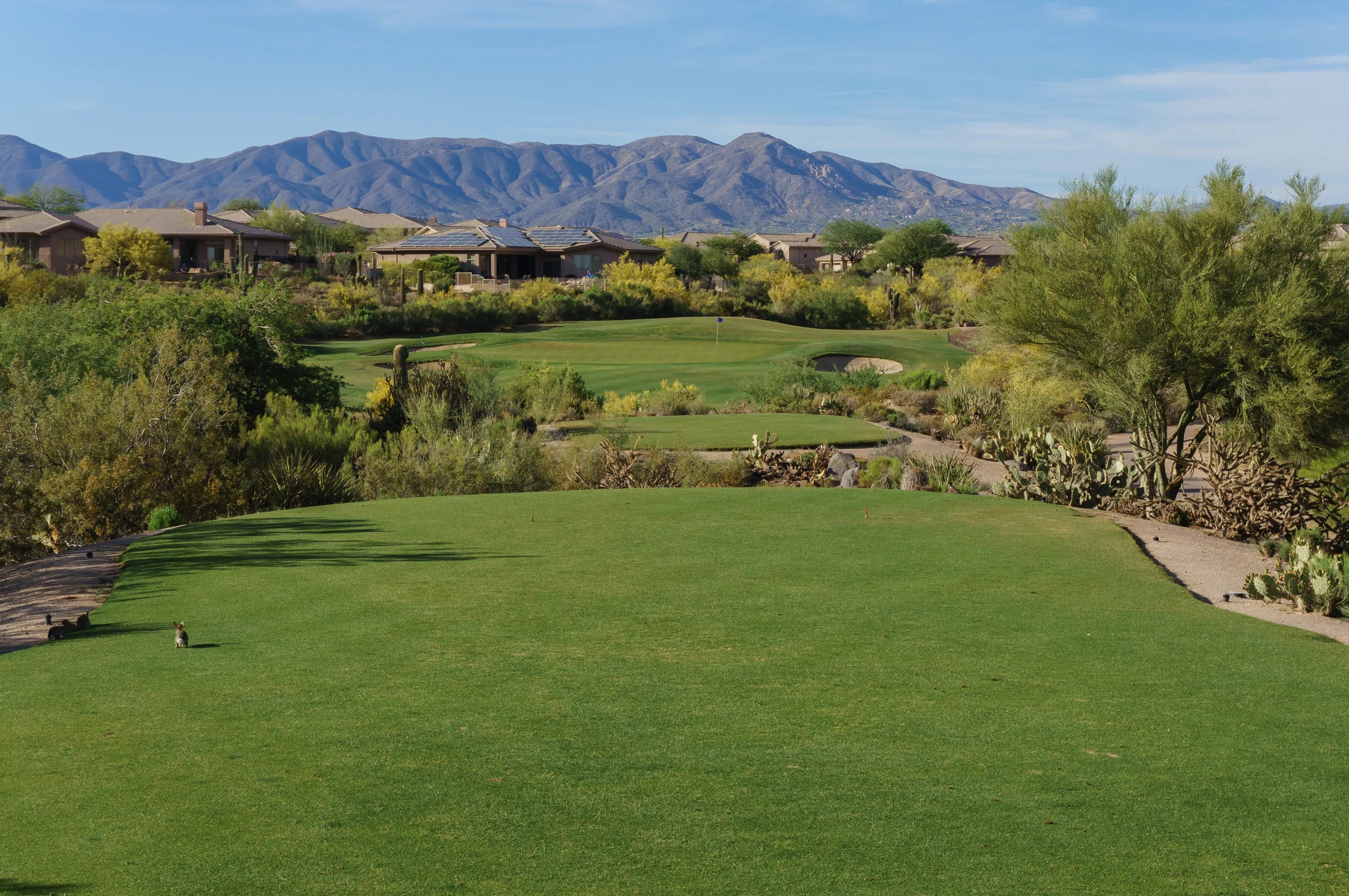
Vidler Water Company sells water to golf courses “every quarter,” CEO Dorothy Timian-Palmer said.
Meanwhile, as Vidler continued pouring water and money into its recharge facility, it bought more land with water rights in Maricopa and La Paz counties. It leased land back to farmers and resold property in transactions that accounted for most of its revenue. Throughout the mid-2000s, Vidler’s profits, which were also affected by its dealings in other states, fluctuated wildly. It netted more than $56 million in income in 2005, much of that from selling land in the Harquahala Valley. It lost nearly $2.5 million in 2006 and more than $5.2 million the following year, then raked in more than $4.8 million in 2008.
In 2010, Vidler purchased a company with water credits in Phoenix. In 2013, it made $6.3 million selling about 1,000 acres of land and groundwater rights in the Harquahala Valley to Scottsdale for two of the city’s golf courses. But the company continued to lose money, operating at losses of more than $12.5 million in 2014 and nearly $4 million in 2015. In 2017, Vidler sold the Arizona Water Banking Authority about 50,000 acre-feet of its Phoenix credits, and the same amount to the Central Arizona Groundwater Replenishment District, for a total of $25.9 million.
The District, created by the Legislature in 1993, has been key in creating demand for credits in Arizona. In the areas around Prescott, Tucson, and Phoenix, state law requires developers to put as much water back into the ground as they take out, all in roughly the same geographic area. The District helps developers meet that requirement, but it doesn’t have to buy actual water and put it in the ground. Instead, it can buy credits from others who’ve already done so. Critics level that the District allowed development in areas that had no renewable water supply.
“What we’re talking about is transfers of water from the place where there is water to a place where there isn’t water,” said Sarah Porter, director of the Kyl Center for Water Policy at Arizona State University. “I think that there’s more speculation in water as a result of the creation of [the District].”
Today, credits are an accepted part of Arizona water management. Cities, tribes, irrigation districts, and utilities like the Salt River Project all have them; exchanging them is an essential part of Arizona’s Colorado River drought plan.
Water shouldn’t be driven by who has the most money. — Maureen George, retired water attorney
To Sharon Megdal, the Central Arizona Project board member who fielded Timian-Palmer and Vasquez’s calls, this system has value.
“I don’t tend to like to get into, ‘Is it a good thing or a bad thing that you have people making money off of water?’ It is the legal structure that we have,” said Megdal, an economist who is the director of the Water Resources Research Center at the University of Arizona. “If people don’t like that structure, it’s up to them to see about changing it. However, I think … the ability to accrue credits in one place and do something with them somewhere else is turning out to be a useful tool for us.”
Maureen George, the retired water attorney, saw more problems with these kinds of exchanges.
“It becomes a question of whether or not you believe water should go to the highest bidder,” George said.
The county that George represented until her retirement, Mohave, is home to the community that forced Water Asset Management to drop a deal with Central Arizona Project last summer.
“I guess my view … is that water should be available to everyone and it shouldn’t be driven by who has the most money,” she said.
Those who have dealt with Vidler in Arizona largely fit that description – developers and the state entities that help them, or Scottsdale golf courses.
Historically, George mused, “it’s been the conquering people, with more soldiers or more money, who get the water.”
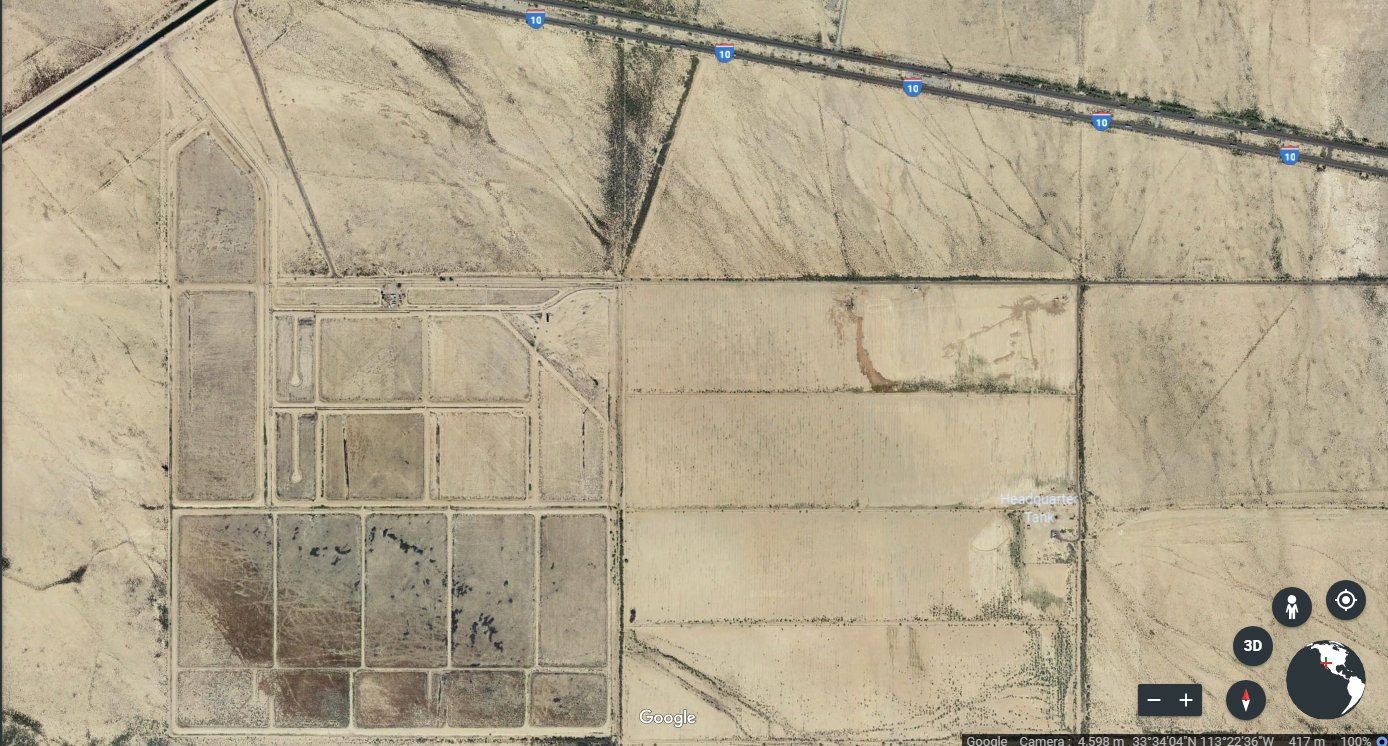
Vidler’s supply of excess Colorado River water dried up after 2010.
Image from Google Earth
Vidler has stashed away more than 250,000 acre-feet of water in its recharge facility in the Harquahala Valley – a quarter of its capacity of 1 million acre-feet. The final year Vidler bought excess Colorado River water was 2010, when it put 50,000 acre-feet into the aquifer. After that, the supply dried up.
It is still actively trying to sell that water. But no one seems to want it, for a range of legal and technical issues.
Scottsdale, whose golf courses paid $10 million for the land that the city bought from Vidler in the Harquahala Valley, is grappling with those very issues now.
“We bought the land so that we could pump groundwater” for the golf courses, said Brian Biesemeyer, the executive director of Scottsdale’s Water Department. But because it can’t legally transport that water through the Central Arizona Project canal, it can’t pump or use it. It wasn’t until 2017 that funneling non-Colorado River water through the Central Arizona Project canal became legally possible; today, anyone who wants to do so still has to secure individual agreements with the Central Arizona Project and the Bureau of Reclamation.
Scottsdale is now enmeshed in this process, which Biesemeyer expected to take another 18 months or two years. After that, it should be able take groundwater from the Harquahala Valley and bring it to golf courses in Scottsdale.
These legal requirements, plus unresolved concerns about water quality, help explain why no one seems interested in the water that Vidler stored in the Harquahala Valley.
In October, after Megdal told Cooke and Grignano that Timian-Palmer was thinking about “going dark” for a while, Cooke responded, “I think part of the issue might be that Vidler has consistently wanted to make their Harquahala credits a part of any deal, and those have transportation … and water quality issues associated with them, and consequently are of much lower value,” he wrote.
The day before, he had written to two fellow staff, including Grignano, “I’m not interested in Harquahala Valley credits at this time, but that is up to you all.”
No one seems interested in the water that Vidler stored in the Harquahala Valley.
And that hints at why last fall, Vasquez and Timian-Palmer struck out.
Right around the time Arizona’s Colorado River drought negotiations stood at an impasse, they both offered water to the leaders of those negotiations – Cooke, and the director of the Arizona Department of Water Resources, Tom Buschatzke. Vasquez offered groundwater in the Harquahala Valley, describing it as “a drought-proof Central Arizona water supply.” It could produce nearly 80,000 acre-feet a year, starting in two or three years, he wrote.
Two weeks later, Timian-Palmer called Cooke, who told her to send a written proposal of the water Vidler wanted to sell. She offered any or all of its 250,000 credits in the Harquahala Valley, at a starting price of $250 per credit, and any or all of its nearly 53,000 credits in Phoenix, for a starting price of $350 per credit.
As this article went to print, Arizona’s drought plan, which spells out how cities, tribes, farmers, and others will be compensated for cuts to their Colorado River water, was in its final stages. No water from Vidler or Water Asset Management was in it.
“I thought we had a resource that could be helpful,” Timian-Palmer said. “Somebody needs a water resource, a credit, in Arizona, I’m going to say, ‘We’ve got these, I can work with you on these.’ But that’s not what they wanted.”
Last fall, the District hadn’t been interested in Vidler or Water Asset Management’s water because of the pending deal with the Gila River Indian Community, Grignano said. The District ultimately inked a $97.5 million deal to buy enough water from the Gila River Indian Community to fulfill “a substantial portion” of the water it would need over the next 25 years.
“We didn’t want to act on any other offers,” she said. “We periodically get proposals from both Water Asset Management and Vidler, and again, we just have to assess our needs at the time.”
According to Grignano and Megdal, as well as several water lawyers, water in the Harquahala Valley is too expensive and has too many legal and technical obstacles to be desirable for now. Water in the Harquahala Valley is “definitely a potential supply in the future,” Grignano added. “It’ll just take some time to develop.”
Twenty years after it began stowing thousands of acre-feet of water in the Harquahala Valley, Vidler has yet to sell a single gallon of it. Although it has made millions selling land and water rights, its most recent 10-K filing contained a hint of possible defeat.
It might never sell, much less profit from, the water it had stored underground, Vidler admitted – water that, decades ago, it expected to someone to pay good money for, no matter how long it took.